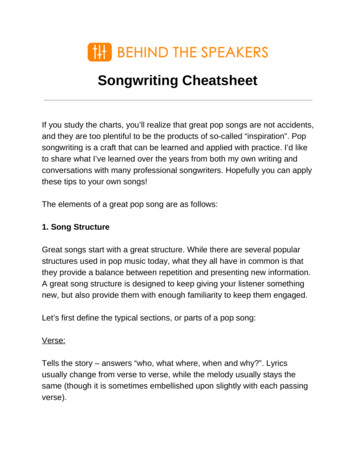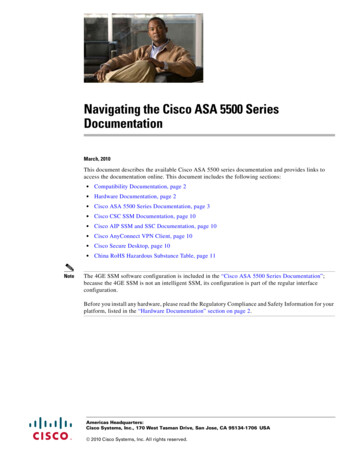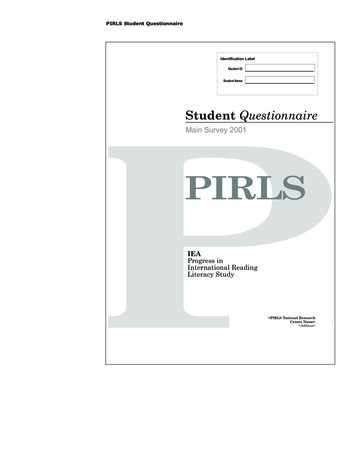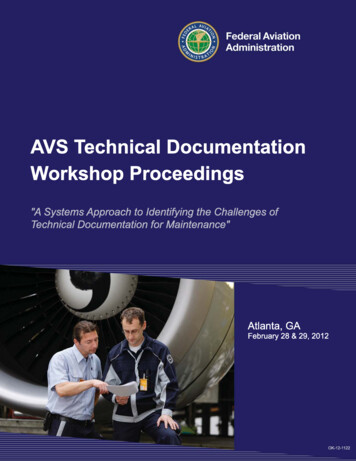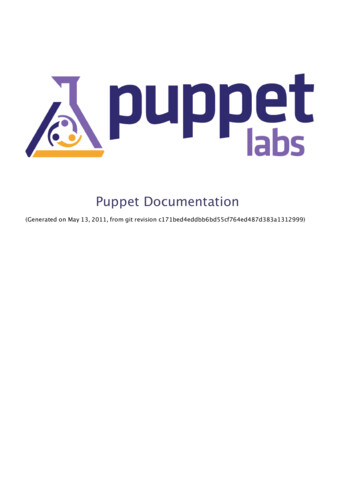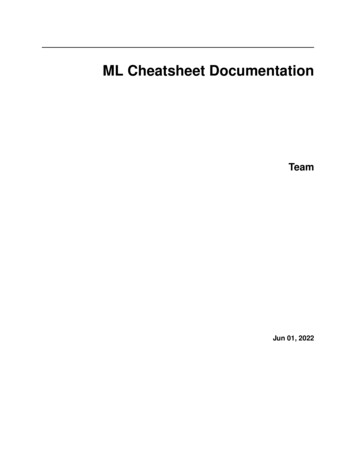
Transcription
ML Cheatsheet DocumentationTeamJun 01, 2022
Basics1Linear Regression32Gradient Descent213Logistic Regression254Glossary395Calculus456Linear Algebra577Probability678Statistics699Notation7110 Concepts7511 Forwardpropagation8112 Backpropagation9113 Activation Functions9714 Layers10515 Loss Functions11716 Optimizers12117 Regularization12718 Architectures13719 Classification Algorithms15120 Clustering Algorithms161i
21 Regression Algorithms16322 Reinforcement Learning16523 Datasets16924 Libraries18525 Papers21526 Other Content22127 Contribute227ii
ML Cheatsheet DocumentationBrief visual explanations of machine learning concepts with diagrams, code examples and links to resources forlearning more.Warning: This document is under early stage development. If you find errors, please raise an issue or contributea better definition!Basics1
ML Cheatsheet Documentation2Basics
CHAPTER1Linear Regression Introduction Simple regression– Making predictions– Cost function– Gradient descent– Training– Model evaluation– Summary Multivariable regression– Growing complexity– Normalization– Making predictions– Initialize weights– Cost function– Gradient descent– Simplifying with matrices– Bias term– Model evaluation3
ML Cheatsheet Documentation1.1 IntroductionLinear Regression is a supervised machine learning algorithm where the predicted output is continuous and has aconstant slope. It’s used to predict values within a continuous range, (e.g. sales, price) rather than trying to classifythem into categories (e.g. cat, dog). There are two main types:Simple regressionSimple linear regression uses traditional slope-intercept form, where 𝑚 and 𝑏 are the variables our algorithm will tryto “learn” to produce the most accurate predictions. 𝑥 represents our input data and 𝑦 represents our prediction.𝑦 𝑚𝑥 𝑏Multivariable regressionA more complex, multi-variable linear equation might look like this, where 𝑤 represents the coefficients, or weights,our model will try to learn.𝑓 (𝑥, 𝑦, 𝑧) 𝑤1 𝑥 𝑤2 𝑦 𝑤3 𝑧The variables 𝑥, 𝑦, 𝑧 represent the attributes, or distinct pieces of information, we have about each observation. Forsales predictions, these attributes might include a company’s advertising spend on radio, TV, and newspapers.𝑆𝑎𝑙𝑒𝑠 𝑤1 𝑅𝑎𝑑𝑖𝑜 𝑤2 𝑇 𝑉 𝑤3 𝑁 𝑒𝑤𝑠1.2 Simple regressionLet’s say we are given a dataset with the following columns (features): how much a company spends on Radioadvertising each year and its annual Sales in terms of units sold. We are trying to develop an equation that will let usto predict units sold based on how much a company spends on radio advertising. The rows (observations) eRadio ( )37.839.345.941.3Sales22.110.418.318.51.2.1 Making predictionsOur prediction function outputs an estimate of sales given a company’s radio advertising spend and our current valuesfor Weight and Bias.𝑆𝑎𝑙𝑒𝑠 𝑊 𝑒𝑖𝑔ℎ𝑡 · 𝑅𝑎𝑑𝑖𝑜 𝐵𝑖𝑎𝑠Weight the coefficient for the Radio independent variable. In machine learning we call coefficients weights.Radio the independent variable. In machine learning we call these variables features.Bias the intercept where our line intercepts the y-axis. In machine learning we can call intercepts bias. Bias offsetsall predictions that we make.4Chapter 1. Linear Regression
ML Cheatsheet DocumentationOur algorithm will try to learn the correct values for Weight and Bias. By the end of our training, our equation willapproximate the line of best fit.Codedef predict sales(radio, weight, bias):return weight*radio bias1.2.2 Cost functionThe prediction function is nice, but for our purposes we don’t really need it. What we need is a cost function so wecan start optimizing our weights.Let’s use MSE (L2) as our cost function. MSE measures the average squared difference between an observation’sactual and predicted values. The output is a single number representing the cost, or score, associated with our currentset of weights. Our goal is to minimize MSE to improve the accuracy of our model.MathGiven our simple linear equation 𝑦 𝑚𝑥 𝑏, we can calculate MSE as:𝑛1 ︁(𝑦𝑖 (𝑚𝑥𝑖 𝑏))2𝑀 𝑆𝐸 𝑁 𝑖 11.2. Simple regression5
ML Cheatsheet DocumentationNote: 𝑁 is the total number of observations (data points) ︀𝑛 𝑁1 𝑖 1 is the mean 𝑦𝑖 is the actual value of an observation and 𝑚𝑥𝑖 𝑏 is our predictionCodedef cost function(radio, sales, weight, bias):companies len(radio)total error 0.0for i in range(companies):total error (sales[i] - (weight*radio[i] bias))**2return total error / companies1.2.3 Gradient descentTo minimize MSE we use Gradient Descent to calculate the gradient of our cost function. Gradient descent consists oflooking at the error that our weight currently gives us, using the derivative of the cost function to find the gradient (Theslope of the cost function using our current weight), and then changing our weight to move in the direction opposite ofthe gradient. We need to move in the opposite direction of the gradient since the gradient points up the slope insteadof down it, so we move in the opposite direction to try to decrease our error.MathThere are two parameters (coefficients) in our cost function we can control: weight 𝑚 and bias 𝑏. Since we need toconsider the impact each one has on the final prediction, we use partial derivatives. To find the partial derivatives, weuse the Chain rule. We need the chain rule because (𝑦 (𝑚𝑥 𝑏))2 is really 2 nested functions: the inner function𝑦 (𝑚𝑥 𝑏) and the outer function 𝑥2 .Returning to our cost function:𝑛1 ︁(𝑦𝑖 (𝑚𝑥𝑖 𝑏))2𝑓 (𝑚, 𝑏) 𝑁 𝑖 1Using the following:(𝑦𝑖 (𝑚𝑥𝑖 𝑏))2 𝐴(𝐵(𝑚, 𝑏))We can split the derivative into𝐴(𝑥) 𝑥2𝑑𝑓 𝐴′ (𝑥) 2𝑥𝑑𝑥and𝐵(𝑚, 𝑏) 𝑦𝑖 (𝑚𝑥𝑖 𝑏) 𝑦𝑖 𝑚𝑥𝑖 𝑏𝑑𝑥 𝐵 ′ (𝑚) 0 𝑥𝑖 0 𝑥𝑖𝑑𝑚𝑑𝑥 𝐵 ′ (𝑏) 0 0 1 1𝑑𝑏6Chapter 1. Linear Regression
ML Cheatsheet DocumentationAnd then using the Chain rule which states:𝑑𝑓 𝑑𝑥𝑑𝑓 𝑑𝑚𝑑𝑥 𝑑𝑚𝑑𝑓𝑑𝑓 𝑑𝑥 𝑑𝑏𝑑𝑥 𝑑𝑏We then plug in each of the parts to get the following derivatives𝑑𝑓 𝐴′ (𝐵(𝑚, 𝑓 ))𝐵 ′ (𝑚) 2(𝑦𝑖 (𝑚𝑥𝑖 𝑏)) · 𝑥𝑖𝑑𝑚𝑑𝑓 𝐴′ (𝐵(𝑚, 𝑓 ))𝐵 ′ (𝑏) 2(𝑦𝑖 (𝑚𝑥𝑖 𝑏)) · 1𝑑𝑏We can calculate the gradient of this cost function as:]︂[︂ 𝑑𝑓 ]︂ [︂ 1 ︀𝑁 ︀ 𝑥𝑖 · 2(𝑦𝑖 (𝑚𝑥𝑖 𝑏)) 𝑓 ′ (𝑚, 𝑏) 𝑑𝑚1𝑑𝑓 1 · 2(𝑦𝑖 (𝑚𝑥𝑖 𝑏))𝑁𝑑𝑏[︂ 1 ︀]︂ 2𝑥𝑖 (𝑦𝑖 (𝑚𝑥𝑖 𝑏))𝑁 ︀ (1.2)1 2(𝑦𝑖 (𝑚𝑥𝑖 𝑏))𝑁(1.1)CodeTo solve for the gradient, we iterate through our data points using our new weight and bias values and take the averageof the partial derivatives. The resulting gradient tells us the slope of our cost function at our current position (i.e.weight and bias) and the direction we should update to reduce our cost function (we move in the direction opposite thegradient). The size of our update is controlled by the learning rate.def update weights(radio, sales, weight, bias, learning rate):weight deriv 0bias deriv 0companies len(radio)for i in range(companies):# Calculate partial derivatives# -2x(y - (mx b))weight deriv -2*radio[i] * (sales[i] - (weight*radio[i] bias))# -2(y - (mx b))bias deriv -2*(sales[i] - (weight*radio[i] bias))# We subtract because the derivatives point in direction of steepest ascentweight - (weight deriv / companies) * learning ratebias - (bias deriv / companies) * learning ratereturn weight, bias1.2.4 TrainingTraining a model is the process of iteratively improving your prediction equation by looping through the datasetmultiple times, each time updating the weight and bias values in the direction indicated by the slope of the costfunction (gradient). Training is complete when we reach an acceptable error threshold, or when subsequent trainingiterations fail to reduce our cost.Before training we need to initialize our weights (set default values), set our hyperparameters (learning rate andnumber of iterations), and prepare to log our progress over each iteration.1.2. Simple regression7
ML Cheatsheet DocumentationCodedef train(radio, sales, weight, bias, learning rate, iters):cost history []for i in range(iters):weight,bias update weights(radio, sales, weight, bias, learning rate)#Calculate cost for auditing purposescost cost function(radio, sales, weight, bias)cost history.append(cost)# Log Progressif i % 10 0:print "iter {:d} weight, bias, cost)weight {:.2f}bias {:.4f}cost {:.2}".format(i,return weight, bias, cost history1.2.5 Model evaluationIf our model is working, we should see our cost decrease after every iteration.Loggingiter 1iter 10iter 20iter 30iter 308weight .03weight .28weight .39weight .44weight .46bias .0014bias .0116bias .0177bias .0219bias .0249cost 197.25cost 74.65cost 49.48cost 44.31cost 43.28Chapter 1. Linear Regression
ML Cheatsheet DocumentationVisualizing1.2. Simple regression9
ML Cheatsheet Documentation10Chapter 1. Linear Regression
ML Cheatsheet Documentation1.2. Simple regression11
ML Cheatsheet Documentation12Chapter 1. Linear Regression
ML Cheatsheet DocumentationCost history1.2.6 SummaryBy learning the best values for weight (.46) and bias (.25), we now have an equation that predicts future sales basedon radio advertising investment.𝑆𝑎𝑙𝑒𝑠 .46𝑅𝑎𝑑𝑖𝑜 .025How would our model perform in the real world? I’ll let you think about it :)1.3 Multivariable regressionLet’s say we are given data on TV, radio, and newspaper advertising spend for a list of companies, and our goal is topredict sales in terms of units sold.CompanyAmazonGoogleFacebookApple1.3. Multivariable 3News69.123.134.713.2Units22.110.418.318.513
ML Cheatsheet Documentation1.3.1 Growing complexityAs the number of features grows, the complexity of our model increases and it becomes increasingly difficult tovisualize, or even comprehend, our data.One solution is to break the data apart and compare 1-2 features at a time. In this example we explore how Radio andTV investment impacts Sales.1.3.2 NormalizationAs the number of features grows, calculating gradient takes longer to compute. We can speed this up by “normalizing”our input data to ensure all values are within the same range. This is especially important for datasets with highstandard deviations or differences in the ranges of the attributes. Our goal now will be to normalize our features sothey are all in the range -1 to 1.CodeFor each feature column {#1 Subtract the mean of the column (mean normalization)#2 Divide by the range of the column (feature scaling)}Our input is a 200 x 3 matrix containing TV, Radio, and Newspaper data. Our output is a normalized matrix of thesame shape with all values between -1 and 1.14Chapter 1. Linear Regression
ML Cheatsheet Documentationdef normalize(features):**features(200, 3)features.T(3, 200)We transpose the input matrix, swappingcols and rows to make vector math easier**for feature in features.T:fmean np.mean(feature)frange np.amax(feature) - np.amin(feature)#Vector Subtractionfeature - fmean#Vector Divisionfeature / frangereturn featuresNote: Matrix math. Before we continue, it’s important to understand basic Linear Algebra concepts as well asnumpy functions like numpy.dot().1.3.3 Making predictionsOur predict function outputs an estimate of sales given our current weights (coefficients) and a company’s TV, radio,and newspaper spend. Our model will try to identify weight values that most reduce our cost function.𝑆𝑎𝑙𝑒𝑠 𝑊1 𝑇 𝑉 𝑊2 𝑅𝑎𝑑𝑖𝑜 𝑊3 𝑁 𝑒𝑤𝑠𝑝𝑎𝑝𝑒𝑟def predict(features, weights):**features - (200, 3)weights - (3, 1)predictions - (200,1)**predictions np.dot(features, weights)return predictions1.3.4 Initialize weightsW1 0.0W2 0.0W3 0.0weights np.array([[W1],[W2],[W3]])1.3. Multivariable regression15
ML Cheatsheet Documentation1.3.5 Cost functionNow we need a cost function to audit how our model is performing. The math is the same, except we swap the 𝑚𝑥 𝑏expression for 𝑊1 𝑥1 𝑊2 𝑥2 𝑊3 𝑥3 . We also divide the expression by 2 to make derivative calculations simpler.𝑀 𝑆𝐸 𝑛1 ︁(𝑦𝑖 (𝑊1 𝑥1 𝑊2 𝑥2 𝑊3 𝑥3 ))22𝑁 𝑖 1def cost function(features, targets, weights):**features:(200,3)targets: (200,1)weights:(3,1)returns average squared error among predictions**N len(targets)predictions predict(features, weights)# Matrix math lets use do this without loopingsq error (predictions - targets)**2# Return average squared error among predictionsreturn 1.0/(2*N) * sq error.sum()1.3.6 Gradient descentAgain using the Chain rule we can compute the gradient–a vector of partial derivatives describing the slope of the costfunction for each weight.𝑓 ′ (𝑊1 ) 𝑥1 (𝑦 (𝑊1 𝑥1 𝑊2 𝑥2 𝑊3 𝑥3 ))(1.3)𝑓 ′ (𝑊2 ) 𝑥2 (𝑦 (𝑊1 𝑥1 𝑊2 𝑥2 𝑊3(1.4)𝑥3 ))𝑓 ′ (𝑊3 ) 𝑥3 (𝑦 (𝑊1 𝑥1 𝑊2 𝑥2 𝑊3(1.5)𝑥3 ))def update weights(features, targets, weights, lr):'''Features:(200, 3)Targets: (200, 1)Weights:(3, 1)'''predictions predict(features, weights)#Extract our featuresx1 features[:,0]x2 features[:,1]x3 features[:,2]# Use dot product to calculate the derivative for each weightd w1 -x1.dot(targets - predictions)d w2 -x2.dot(targets - predictions)d w2 -x2.dot(targets - predictions)# Multiply the mean derivative by the learning rate(continues on next page)16Chapter 1. Linear Regression
ML Cheatsheet Documentation(continued from previous page)# and subtract from our weights (remember gradient points in direction of steepest ASCENT)weights[0][0] - (lr * np.mean(d w1))weights[1][0] - (lr * np.mean(d w2))weights[2][0] - (lr * np.mean(d w3))return weightsAnd that’s it! Multivariate linear regression.1.3.7 Simplifying with matricesThe gradient descent code above has a lot of duplication. Can we improve it somehow? One way to refactor would beto loop through our features and weights–allowing our function to handle any number of features. However there isanother even better technique: vectorized gradient descent.MathWe use the same formula as above, but instead of operating on a single feature at a time, we use matrix multiplicationto operative on all features and weights simultaneously. We replace the 𝑥𝑖 terms with a single feature matrix 𝑋.𝑔𝑟𝑎𝑑𝑖𝑒𝑛𝑡 𝑋(𝑡𝑎𝑟𝑔𝑒𝑡𝑠 𝑝𝑟𝑒𝑑𝑖𝑐𝑡𝑖𝑜𝑛𝑠)CodeX [[x1, x2, x3][x1, x2, x3].[x1, x2, x3]]targets [[1],[2],[3]]def update weights vectorized(X, targets, weights, lr):**gradient X.T * (predictions - targets) / NX: (200, 3)Targets: (200, 1)Weights: (3, 1)**companies len(X)#1 - Get Predictionspredictions predict(X, weights)(continues on next page)1.3. Multivariable regression17
ML Cheatsheet Documentation(continued from previous page)#2 - Calculate error/losserror targets - predictions#3 Transpose features from (200, 3) to (3, 200)# So we can multiply w the (200,1) error matrix.# Returns a (3,1) matrix holding 3 partial derivatives -# one for each feature -- representing the aggregate# slope of the cost function across all observationsgradient np.dot(-X.T, error)#4 Take the average error derivative for each featuregradient / companies#5 - Multiply the gradient by our learning rategradient * lr#6 - Subtract from our weights to minimize costweights - gradientreturn weights1.3.8 Bias termOur train function is the same as for simple linear regression, however we’re going to make one final tweak beforerunning: add a bias term to our feature matrix.In our example, it’s very unlikely that sales would be zero if companies stopped advertising. Possible reasons for thismight include past advertising, existing customer relationships, retail locations, and salespeople. A bias term will helpus capture this base case.CodeBelow we add a constant 1 to our features matrix. By setting this value to 1, it turns our bias term into a constant.bias np.ones(shape (len(features),1))features np.append(bias, features, axis 1)1.3.9 Model evaluationAfter training our model through 1000 iterations with a learning rate of .0005, we finally arrive at a set of weights wecan use to make predictions:𝑆𝑎𝑙𝑒𝑠 4.7𝑇 𝑉 3.5𝑅𝑎𝑑𝑖𝑜 .81𝑁 𝑒𝑤𝑠𝑝𝑎𝑝𝑒𝑟 13.9Our MSE cost dropped from 110.86 to 6.25.18Chapter 1. Linear Regression
ML Cheatsheet DocumentationReferences1.3. Multivariable regression19
ML Cheatsheet Documentation20Chapter 1. Linear Regression
CHAPTER2Gradient DescentGradient descent is an optimization algorithm used to minimize some function by iteratively moving in the directionof steepest descent as defined by the negative of the gradient. In machine learning, we use gradient descent to updatethe parameters of our model. Parameters refer to coefficients in Linear Regression and weights in neural networks.2.1 IntroductionConsider the 3-dimensional graph below in the context of a cost function. Our goal is to move from the mountain inthe top right corner (high cost) to the dark blue sea in the bottom left (low cost). The arrows represent the direction ofsteepest descent (negative gradient) from any given point–the direction that decreases the cost function as quickly aspossible. SourceStarting at the top of the mountain, we take our first step downhill in the direction specified by the negative gradient.Next we recalculate the negative gradient (passing in the coordinates of our new point) and take another step in thedirection it specifies. We continue this process iteratively until we get to the bottom of our graph, or to a point wherewe can no longer move downhill–a local minimum. image source.21
ML Cheatsheet Documentation2.2 Learning rateThe size of these steps is called the learning rate. With a high learning rate we can cover more ground each step, butwe risk overshooting the lowest point since the slope of the hill is constantly changing. With a very low learning rate,we can confidently move in the direction of the negative gradient since we are recalculating it so frequently. A lowlearning rate is more precise, but calculating the gradient is time-consuming, so it will take us a very long time to getto the bottom.2.3 Cost functionA Loss Functions tells us “how good” our model is at making predictions for a given set of parameters. The costfunction has its own curve and its own gradients. The slope of this curve tells us how to update our parameters to makethe model more accurate.2.4 Step-by-stepNow let’s run gradient descent using our new cost function. There are two parameters in our cost function we cancontrol: 𝑚 (weight) and 𝑏 (bias). Since we need to consider the impact each one has on the final prediction, we needto use partial derivatives. We calculate the partial derivatives of the cost function with respect to each parameter andstore the results in a gradient.MathGiven the cost function:𝑓 (𝑚, 𝑏) 22𝑛1 ︁(𝑦𝑖 (𝑚𝑥𝑖 𝑏))2𝑁 𝑖 1Chapter 2. Gradient Descent
ML Cheatsheet DocumentationThe gradient can be calculated as:𝑓 ′ (𝑚, 𝑏) [︂𝑑𝑓𝑑𝑚𝑑𝑓𝑑𝑏]︂ ]︂[︂ 1 ︀𝑁 ︀ 2𝑥𝑖 (𝑦𝑖 (𝑚𝑥𝑖 𝑏))1 2(𝑦𝑖 (𝑚𝑥𝑖 𝑏))𝑁To solve for the gradient, we iterate through our data points using our new 𝑚 and 𝑏 values and compute the partialderivatives. This new gradient tells us the slope of our cost function at our current position (current parameter values)and the direction we should move to update our parameters. The size of our update is controlled by the learning rate.Codedef update weights(m, b, X, Y, learning rate):m deriv 0b deriv 0N len(X)for i in range(N):# Calculate partial derivatives# -2x(y - (mx b))m deriv -2*X[i] * (Y[i] - (m*X[i] b))# -2(y - (mx b))b deriv -2*(Y[i] - (m*X[i] b))# We subtract because the derivatives point in direction of steepest ascentm - (m deriv / float(N)) * learning rateb - (b deriv / float(N)) * learning ratereturn m, bReferences2.4. Step-by-step23
ML Cheatsheet Documentation24Chapter 2. Gradient Descent
CHAPTER3Logistic Regression Introduction– Comparison to linear regression– Types of logistic regression Binary logistic regression– Sigmoid activation– Decision boundary– Making predictions– Cost function– Gradient descent– Mapping probabilities to classes– Training– Model evaluation Multiclass logistic regression– Procedure– Softmax activation– Scikit-Learn example3.1 IntroductionLogistic regression is a classification algorithm used to assign observations to a discrete set of classes. Unlike linearregression which outputs continuous number values, logistic regression transforms its output using the logistic sigmoid25
ML Cheatsheet Documentationfunction to return a probability value which can then be mapped to two or more discrete classes.3.1.1 Comparison to linear regressionGiven data on time spent studying and exam scores. Linear Regression and logistic regression can predict differentthings: Linear Regression could help us predict the student’s test score on a scale of 0 - 100. Linear regressionpredictions are continuous (numbers in a range). Logistic Regression could help use predict whether the student passed or failed. Logistic regression predictionsare discrete (only specific values or categories are allowed). We can also view probability scores underlying themodel’s classifications.3.1.2 Types of logistic regression Binary (Pass/Fail) Multi (Cats, Dogs, Sheep) Ordinal (Low, Medium, High)3.2 Binary logistic regressionSay we’re given data on student exam results and our goal is to predict whether a student will pass or fail based onnumber of hours slept and hours spent studying. We have two features (hours slept, hours studied) and two classes:passed (1) and failed ssed1010Graphically we could represent our data with a scatter plot.26Chapter 3. Logistic Regression
ML Cheatsheet Documentation3.2.1 Sigmoid activationIn order to map predicted values to probabilities, we use the sigmoid function. The function maps any real value intoanother value between 0 and 1. In machine learning, we use sigmoid to map predictions to probabilities.Math𝑆(𝑧) 11 𝑒 𝑧Note: 𝑠(𝑧) output between 0 and 1 (probability estimate) 𝑧 input to the function (your algorithm’s prediction e.g. mx b) 𝑒 base of natural log3.2. Binary logistic regression27
ML Cheatsheet DocumentationGraphCodedef sigmoid(z):return 1.0 / (1 np.exp(-z))3.2.2 Decision boundaryOur current prediction function returns a probability score between 0 and 1. In order to map this to a discrete class(true/false, cat/dog), we select a threshold value or tipping point above which we will classify values into class 1 andbelow which we classify values into class 2.𝑝 0.5, 𝑐𝑙𝑎𝑠𝑠 1𝑝 0.5, 𝑐𝑙𝑎𝑠𝑠 028Chapter 3. Logistic Regression
ML Cheatsheet DocumentationFor example, if our threshold was .5 and our prediction function returned .7, we would classify this observation aspositive. If our prediction was .2 we would classify the observation as negative. For logistic regression with multipleclasses we could select the class with the highest predicted probability.3.2.3 Making predictionsUsing our knowledge of sigmoid functions and decision boundaries, we can now write a prediction function. Aprediction function in logistic regression returns the probability of our observation being positive, True, or “Yes”. Wecall this class 1 and its notation is 𝑃 (𝑐𝑙𝑎𝑠𝑠 1). As the probability gets closer to 1, our model is more confident thatthe observation is in class 1.MathLet’s use the same multiple linear regression equation from our linear regression tutorial.𝑧 𝑊0 𝑊1 𝑆𝑡𝑢𝑑𝑖𝑒𝑑 𝑊2 𝑆𝑙𝑒𝑝𝑡This time however we will transform the output using the sigmoid function to return a probability value between 0 and1.𝑃 (𝑐𝑙𝑎𝑠𝑠 1) 11 𝑒 𝑧If the model returns .4 it believes there is only a 40% chance of passing. If our decision boundary was .5, we wouldcategorize this observation as “Fail.””CodeWe wrap the sigmoid function over the same prediction function we used in multiple linear regression3.2. Binary logistic regression29
ML Cheatsheet Documentationdef predict(features, weights):'''Returns 1D array of probabilitiesthat the class label 1'''z np.dot(features, weights)return sigmoid(z)3.2.4 Cost functionUnfortunately we can’t (or at least shouldn’t) use the same cost function MSE (L2) as we did for linear regression.Why? There is a great math explanation in chapter 3 of Michael Neilson’s deep learning book5 , but for now I’ll simplysay it’s because our prediction function is non-linear (due to sigmoid transform). Squaring this prediction as we doin MSE results in a non-convex function with many local minimums. If our cost function has many local minimums,gradient descent may not find the optimal global minimum.MathInstead of Mean Squared Error, we use a cost function called Cross-Entropy, also known as Log Loss. Cross-entropyloss can be divided into two separate cost functions: one for 𝑦 1 and one for 𝑦 0.The benefits of taking the logarithm reveal themselves when you look at the cost function graphs for y 1 and y 0.These smooth monotonic functions7 (always increasing or always decreasing) make it easy to calculate the gradientand minimize cost. Image from Andrew Ng’s slides on logistic regression1 onic functionhttp://www.holehouse.org/mlclass/06 Logistic Regression.htmlChapter 3. Logistic Regression
ML Cheatsheet DocumentationThe key thing to note is the cost function penalizes confident and wrong predictions more than it rewards confidentand right predictions! The corollary is increasing prediction accuracy (closer to 0 or 1) has diminishing returns onreducing cost due to the logistic nature of our cost function.Above functions compressed into oneMultiplying by 𝑦 and (1 𝑦) in the above equation is a sneaky trick that let’s us use the same equation to solve forboth y 1 and y 0 cases. If y 0, the first side cancels out. If y 1, the second side cancels out. In both cases we onlyperform the operation we need to perform.Vectorized cost functionCodedef cost function(features, labels, weights):'''Using Mean Absolute ErrorFeatures:(100,3)Labels: (100,1)Weights:(3,1)(continues on next page)3.2. Binary logistic regression31
ML Cheatsheet Documentation(continued from previous page)Returns 1D matrix of predictionsCost (labels*log(predictions) (1-labels)*log(1-predictions) ) / len(labels)'''observations len(labels)predictions predict(features, weights)#Take the error when label 1class1 cost -labels*np.log(predictions)#Take the error when label 0class2 cost (1-labels)*np.log(1-predictions)#Take the sum of both costscost class1 cost - class2 cost#Take the average costcost cost.sum() / observationsreturn cost3.2.5 Gradient descentTo minimize our cost, we use Gradient Descent just like before in Linear Regression. There are other more sophisticated optimization algorithms out there such as conjugate gradient like BFGS, but you don’t have to worry about these.Machine learning libraries like Scikit-learn hide their implementations so you can focus on more interesting things!MathOne of the neat properties of the sigmoid function is its derivative is easy to calculate. If you’re curious, there is agood walk-through derivation on stack overflow6 . Michael Neilson also covers the topic in chapter 3 of his book.𝑠′ (𝑧) 𝑠(𝑧)(1 𝑠(𝑧))(3.1)Which leads to an equally beautiful and convenient cost function derivative:𝐶 ′ 𝑥(𝑠(𝑧) 𝑦)Note: 𝐶 ′ is the derivative of cost with respect to weights 𝑦 is the actual class label (0 or 1) 𝑠(𝑧) is your model’s prediction 𝑥 is your feature or feature vector.Notice how this gradient is the same as the MSE (L2) gradient, the only difference is the hypothesis c11e-xChapter 3. Logistic Regression
ML Cheatsheet DocumentationPseudocodeRepeat {1. Calculate gradient average2. Multiply by learning rate3. Subtract from weights}Codedef update weights(features, labels, weights, lr):'''Vectorized Gradient DescentFeatures:(200, 3)Labels: (200, 1)Weights:(3, 1)'''N len(features)#1 - Get Predictionspredictions predict(features, weights)#2 Transpose features from (200, 3) to (3, 200)# So we can multiply w the (200,1) cost matrix.# Returns a (3,1) matrix holding 3 partial derivatives -# one for each feature -- representing the aggregate# slope of the cost function across all observationsgradient np.dot(features.T, predictions - labels)#3 Take the average cost derivative for each featuregradient / N#4 - Multiply the gradient by our learning rategradient * lr#5 - Subtract from our weights to minimize costweights - gradientreturn weights3.2.6 Mapping probabilities to classesThe final step is assign class labels (0 or 1) to our predicted probabilities.Decision boundarydef decision boundary(prob):return 1 if prob .5 else 03.2. Binary logistic regression33
ML Cheatsheet DocumentationConvert probabilities to classesdef classify(predictions):'''input - N element array of predictions between 0 and 1output - N element array of 0s (False) and 1s (True)'''decision boundary np.vectorize(decision boundary)return decision boundary(predictions).flatten()Example outputProbabilities [ 0.967, 0.448, 0.015, 0.780, 0.978, 0.004]Classifications [1, 0, 0, 1, 1, 0]3.2.7 TrainingOur training code is the same as we used for linear regression.def train(features, labels, weights, lr, iters):cost history []for i in range(iters):weights update weights(features, labels, weights, lr)#Calculate error for auditing purposescost cost function(features, labels, weights)cost history.append(cost)# Log Progressif i % 1000 0:print "iter: " str(i) " cost: " str(cost)return weights, cost history3.2.8 Model evaluationIf our model is working, we should see our cost decrease after every iteration.iter: 0 cost: 0.635iter: 1000 cost: 0.302iter: 2000 cost: 0.264Final cost: 0.2487. Final weights: [-8.197, .921, .738]34Chapter 3. Logistic Regression
ML Cheatsheet DocumentationCost historyAccuracyAccuracy measures how correct our predictions were. In this case we simply compare predicted labels to true labelsand divide by the total.def accuracy(predicted labels, actual labe
22 Reinforcement Learning 165 23 Datasets 169 24 Libraries 185 25 Papers 215 26 Other Content 221 27 Contribute 227 ii. ML Cheatsheet Documentation Brief visual explanations of machine learning concepts with diagrams, code examples and links to resources for learning more.

